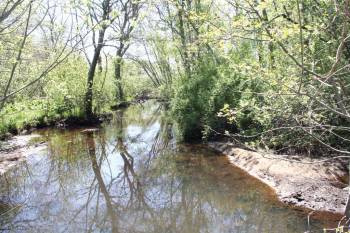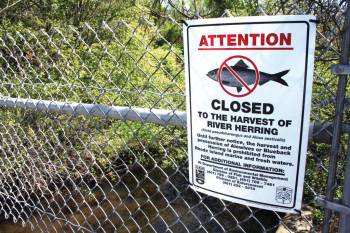

 |
 |
|---|---|
| SPAWNING SITE: This section of Buckeye Brook just after flowing under Lakeshore Drive frequently teemed with spawning herring in years past. | |
Officially, at least according to previous years, the herring run isn’t over for another 10 days.
But, the seasonal clock is about two weeks ahead of itself this year and Paul Earnshaw and the Buckeye Brook Coalition are seeing fewer fish run up the brook to Warwick Pond. Instead, they are seeing fish return to the bay.
Earnshaw, coalition president, is also witnessing what is seen up and down the Atlantic seaboard, an overall depletion of river herring. While counts for Buckeye Brook and across the region haven’t been finalized this year, the overall trend is toward decline. That was confirmed in the 2012 River Herring Stock Assessment Report released last week by the Atlantic States Marine Fisheries Commission (ASMFC). The stock assessment subcommittee (SASC) found of 24 stocks assessed, 92 percent were currently depleted and one was increasing, while 28 of 52 examined rivers lacked sufficient data to determine the condition. Rhode Island’s herring run is the earliest that Phillip Edwards, fisheries biologist for the Department of Environmental Management, can remember. “Early numbers look good, as good as last year if not better,” Edwards said Monday. He said runs slowed in the cooler weather of the past two weeks, but picked up again as of last Friday and the full moon. “It’s exciting to see these runs continue,” he said. Generally, he said, state runs have improved since the state closed the taking of river herring in fresh and marine waters in 2006, but those runs are nothing like they were in the 1990s. Earnshaw believes offshore fisheries are responsible and that river herring – alewife and blueback herring – are unintentionally being caught. This is “bycatch” and he has been vocal in seeking to reduce bycatch.
“Many Rhode Island watershed groups tend to focus on their own individual projects that tend to benefit or improve their water-body. We at the Buckeye Brook Coalition [BBC] understand that Buckeye Brook is an important role in the ecosystem, which affects the lifecycle of many species,” he wrote in an email responding to questions about the assessment.
“I don't believe enough Rhode Island organizations have engaged the herring as they have other problematic fisheries like menhaden. The BBC has put their support into regulation changes to benefit that fishery, too. But at the coalition we are all about herring.”
Judd Crawford, science and policy manager of northeast fishers program at the Pew Environment Group, notes, “There was a time when virtually every river and stream had vigorous runs of river herring. It’s as if a bomb went off and we’re looking at a few survivors.”
In an interview Friday, Crawford said there remain a few healthy stocks in Maine. However, he says an assessment shouldn’t be restricted to one area and that stocks can vary from year to year.
“We need to look across the whole coastline and how they are doing through time,” he said.
Crawford calls the conclusion “grim” and that what we are seeing “is a faint shadow of what we had; an epic migration of animals from the sea bringing up nutrients and most of that is gone.”
Bycatch appears to be a big piece of the puzzle.
The stock assessment was the first to examine ocean bycatch of the fish. According to the report, at-sea fisheries are a significant factor in the decline of the species populations over the last 50 years. Some years, more than 2 million pounds of adult and juvenile river herring are killed incidentally by at-sea fisheries, if not more.
The assessment peer review says that the coast-wide run of river herring was likely in the hundreds of millions of fish in the early 17th and late 19th centuries. Today, individual runs number in the thousands or fewer. The SASC concluded that ocean bycatch is an issue, and that recovery will require management on multiple fronts.
Crawford estimates that river herring runs are 1 to 2 percent of what they were in their heyday. As recently as the 1980s, Buckeye Brook would be teeming with the fish at this time of year. At some times during the run, fish would be flopping on the shore, as the stream was so packed they had no place to go.
While bycatch is a major factor, Crawford says there are others, too.
“There are multiple causes of mortality,” he said. Predators and environmental changes are also working against recovery of these.
“Long-term trends tell us we’re in deep trouble,” he said.
“When I visited Lakeshore Drive, which is an area which provides excellent spawning habitat [except the pollutants from the airport], many days there were fish all over the place. It was sad to see days when there wasn't one, usually some of those cooler days we’ve been experiencing,” Earnshaw reports. Edwards at DEM said that last year’s Buckeye Brook run of 50,500 fish was the best since 2003, when the coalition started keeping count. He hopes this year may be better. Also, he reported, with the removal last year of the Pawtuxet River Falls dam, 1,000 adult brood stock have been introduced into the river and there are reports of spawning fish, although that hasn’t been verified by DEM. The hope is to restore that river run. From June 19 to 21, the New England Marine Fishery Management Council will consider management provisions that would help protect river herring in federal waters by limiting bycatch, among other proposed actions.
Crawford says incentives, such as closing down other fisheries when bycatches reach certain levels, have worked in other areas. He notes that salmon are often bycatches of pollock fishing in Alaska waters. By setting limits on bycatch, areas where salmon are known to be are avoided.
“Further, the National Marine Fisheries Service [NMFS] recently determined that river herring should be examined for protection under the Endangered Species Act, initiating a yearlong scientific process. This new assessment and peer review confirms fears about the condition of river herring and more needs to be done to protect these ecologically vital fish before they are lost all together,” according to a Pew Environment Group release.
The Buckeye Brook Coalition is a member of the Herring Alliance that works to protect and restore ocean wildlife and ecosystems along the Atlantic coast of the United States through precautionary and science-based management of herring, mackerel and other forage fish. For more information, visit HerringAlliance.org.